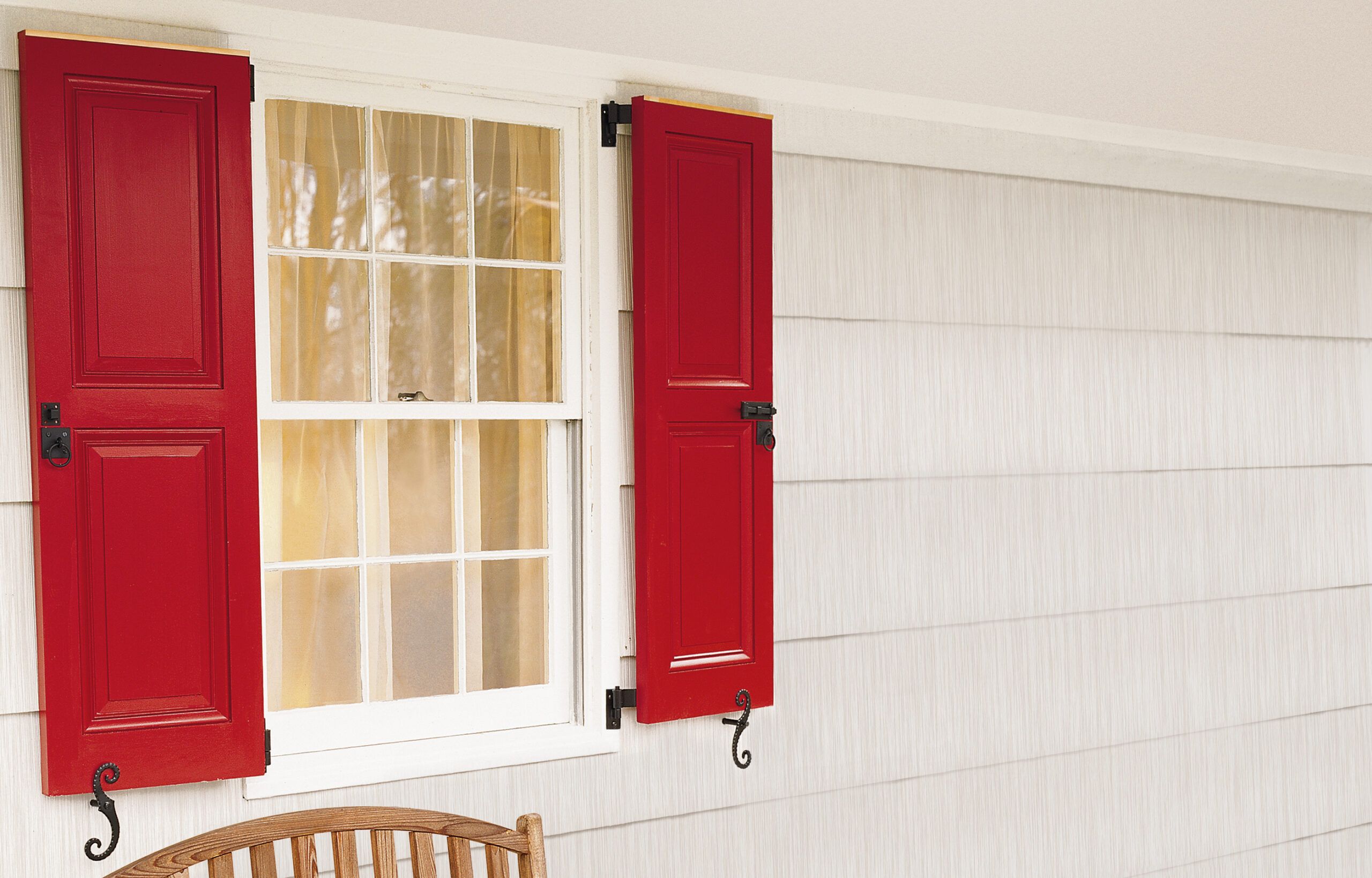Project details
Skill
Cost
Estimated Time
*Cost information in this article sourced from Angi.
 5-In-1 Painter’s Tool
5-In-1 Painter’s Tool Caulk gun
Caulk gun Sawhorses
Sawhorses Adjustable wrench
Adjustable wrench Hammer
Hammer Drill/driver
Drill/driver Drill bit
Drill bit level – 4-foot
level – 4-foot Paint brush
Paint brush Paint roller
Paint roller
Installing shutters on your windows may seem daunting, but with the right approach, it’s a project many homeowners can tackle in a weekend. This guide will walk you through the process of hanging exterior shutters, from selecting the right style to making final adjustments for a perfect fit.
Understanding Exterior Shutters and Their Purpose
Exterior shutters serve both functional and aesthetic purposes, adding character to your home and potentially increasing energy efficiency and security. Before diving into the installation process, we recommend taking a moment to understand the various types of shutters and the best use cases for each. Whether you want a modern look, or vintage style shutters, the perfect exterior shutters are out there.
Types of Exterior Shutters
There are several styles of exterior shutters to choose from, each with its own unique characteristics:
- Bahama shutters: Hinged at the top and prop open from the bottom, ideal for tropical climates.
- Board and batten shutters: Learn how to make rustic style board and batten shutters held together by horizontal battens.
- Louvered shutters: Feature angled slats that allow for airflow and light control.
- Panel shutters: Solid designs that offer a classic, traditional look.
- Estate Shutters: Perfect for large windows, though the cost of estate shutters can be high.
Benefits of Installing Exterior Shutters
Adding exterior shutters to your home can provide numerous advantages:
- Additional privacy and security
- Enhanced curb appeal and architectural interest
- Improved energy efficiency by blocking sunlight and reducing heat gain
- Protection for windows during severe weather using hurricane shutters
- Potential increase in home value
Preparing for Installation of Your Exterior Shutters
Proper preparation is key to a successful shutter installation. This phase involves taking accurate measurements, selecting the right shutters for your home, and gathering all necessary tools and materials.
Measuring Your Windows
To measure for exterior shutters:
- Measure the height of the window opening from the top of the casing to the bottom sill.
- Measure the width of the window opening from one side of the casing to the other.
- Allow for a ¼-inch gap on all sides of the shutters when closed.
Choosing the Right Shutters
When selecting shutters, consider the following factors:
- Color and finish
- Material, such as wood, vinyl, or composite
- Operational vs. decorative shutters
- Style, such as louvered, paneled, or hurricane
Gathering Necessary Tools and Materials
Before beginning installation, ensure you have all required tools and materials:
- Shutters and associated hardware
- Caulk gun and exterior caulk
- Drill/driver and drill bits
- Hammer
- Level
- Tape measure
- Paint and brushes (if painting on-site)
- Pencil
- Screwdriver
- Shims
Step 1: Project overview
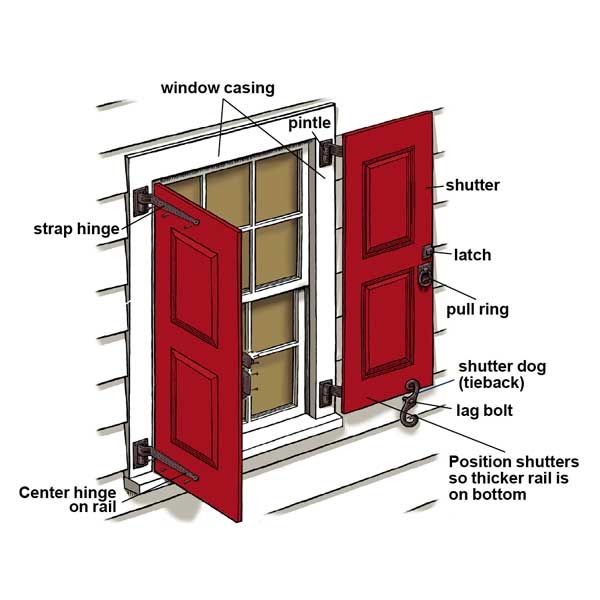
Functional exterior shutters attach to the trim around the window (the casing) and swing into the window opening, resting flush with the casing when closed and latched. When open, the shutters stand proud of the house, held in place by a pivoting metal tieback (also called a shutter dog), a hook, or a catch.
Provided with measurements, companies will custom-make shutters to fit your window openings. Taking the measurement is a critical first step—there should only be a ¼-inch gap on all sides of the shutters when closed, leaving little margin for error. Positioning the shutters so they sit this way is where most homeowners run into difficulty, says This Old House general contractor Tom Silva. “Shutters are meant to fit inside the casing,” he explains. “Many people think they’re supposed to hang outside the casing, but that would make it impossible to close them properly.”
Give yourself a day to get the shutters painted and the windows prepped. Between coats, count the hardware pieces to make sure you have enough of everything for each window. Remove any old shutters on the windows, expecting you’ll need to touch up some paint, fill with caulk, or clean out the cobwebs and dead bugs you’ll find back there. You’ll also need to remove storm windows if you want the shutters to operate.
After preparing and painting the windows, your biggest challenge will be positioning the hinges so the shutters swing straight and close smoothly. This process may take some trial and error on the first pair, but the work gets easier once you get the hang of it.
Step 2: Paint or finish the shutters
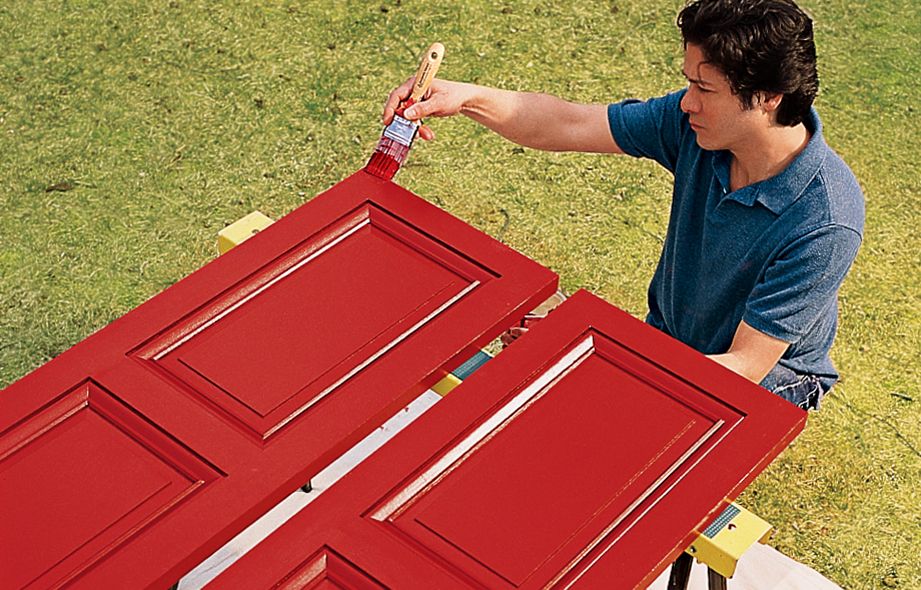
Paint or stain and finish the shutters before installing them.
When painting paneled shutters, use a small roller to coat the panels first, then tip off the paint with a brush. Next, use a brush to paint the horizontal rails and then the vertical stiles with long, feathered strokes.
When painting shutters with movable louvers, make sure to open and close the louvers after you paint them to keep them from sticking.
Always paint all six sides of the shutters—including the top and bottom edges—to protect them against moisture infiltration.
Step 3: Shim the shutters in place
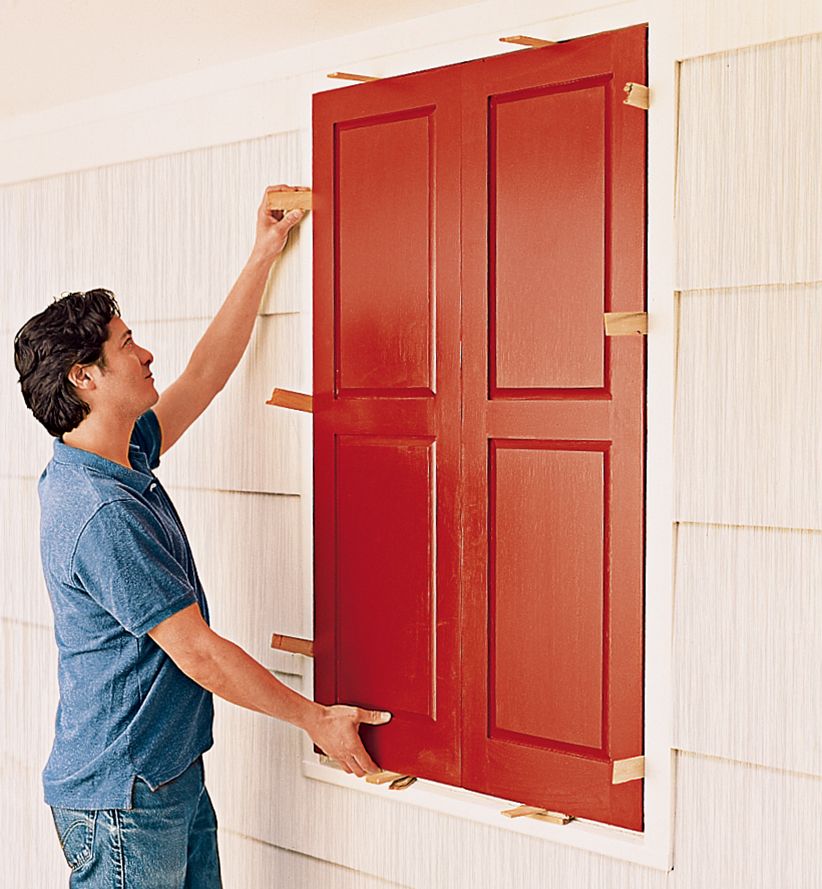
Place one shutter in the window opening. Have a helper hold it as you shim it tight at the top and bottom. Position the other shutter the same way.
Once both shutters are firmly in the window casing, carefully reposition them so they’re centered and surrounded by a ¼-inch gap on all sides. Shim them all around.
TIP: A shutter’s wider rail always goes at the bottom. On paneled shutters, the simpler panels should face out when the shutters are closed. On louvered shutters, the louver openings should face down when the shutters are closed.
Step 4: Install the upper hinge pintles
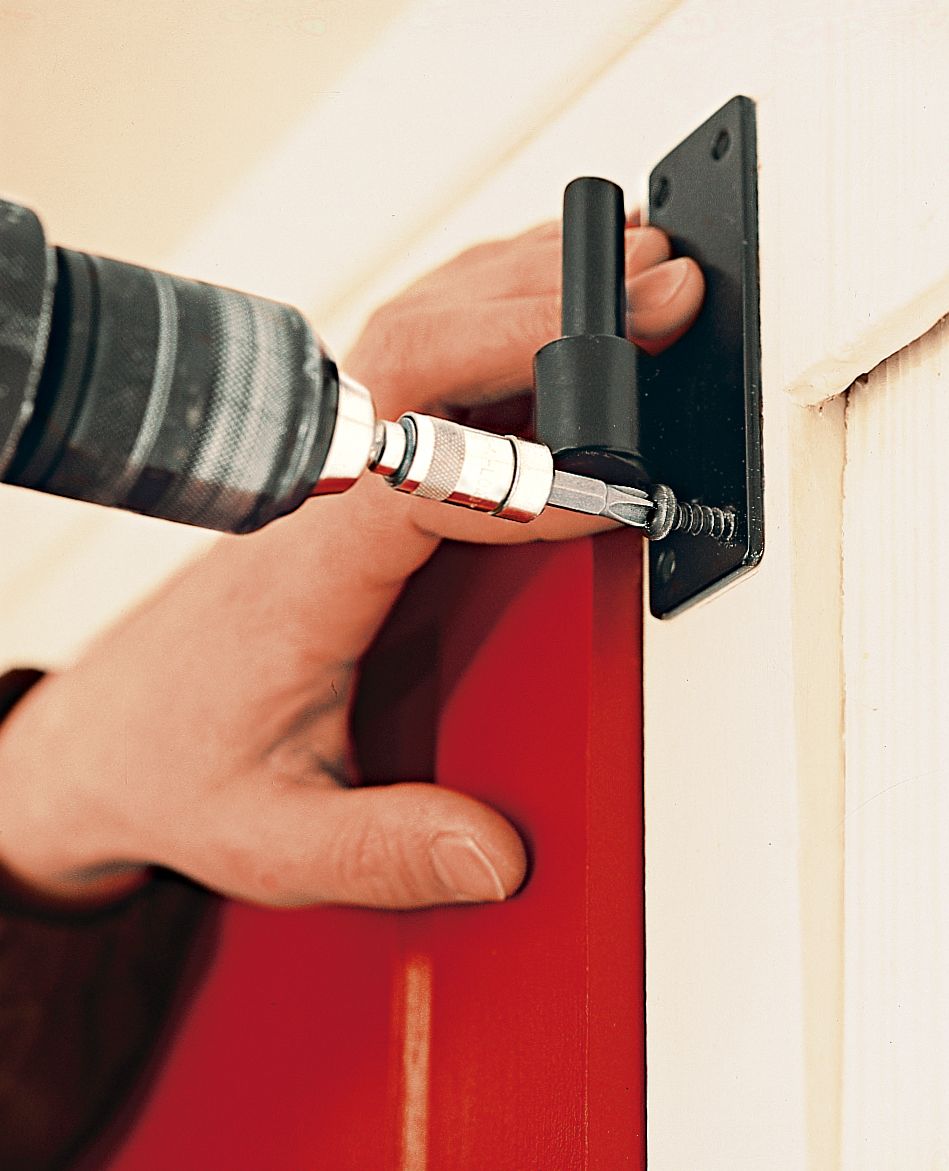
Hook the two parts of a hinge together and position them at the top of one shutter. Center the strap on the top rail and the pintle (peg) on the casing. Using a level, check that the pintle is plumb. Mark the locations of the screw holes for both the strap and the pintle on the shutter and casing.
Set aside the strap. Using a drill/driver fitted with a drill bit sized for your hardware’s screws, drill pilot holes at the marks for the pintle. Screw the pintle to the casing. Repeat this step for the other upper pintle.
Step 5: Install the lower hinge pintles
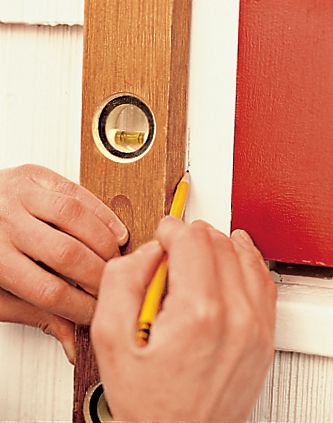
Using a level, draw a plumb line down the casement from the top pintle to the approximate location of the lower hinge. Use this as a reference for positioning and marking the location for the lower hinge, making sure to center it on the bottom rail in the same manner as above. Screw the two lower pintles to the casing.
NOTE: This process works for the strap hinges shown here. For instructions on other hinges, check the manufacturer’s literature.
Step 6: Fasten the hinges to the shutter
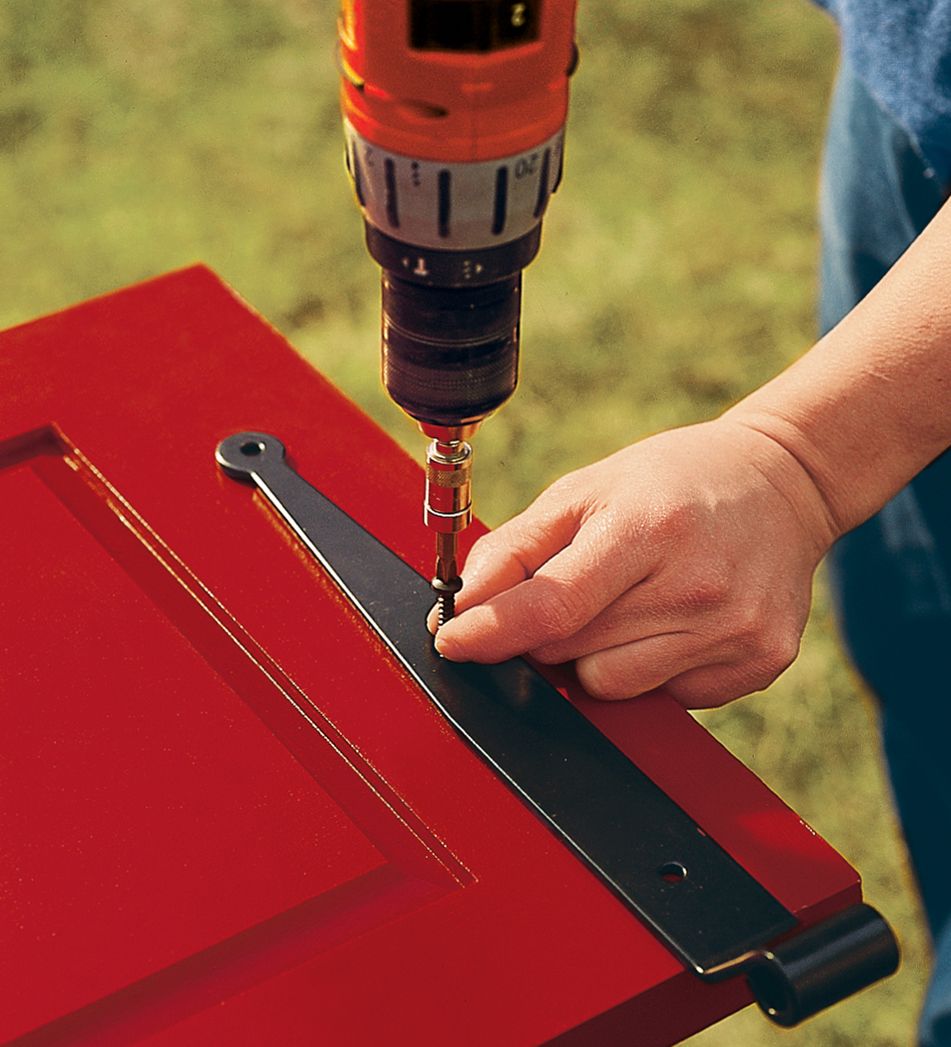
Remove the shutters from the window opening and place them on sawhorses. Using a drill/driver, bore pilot holes at your marks through the strap on the top and bottom rails. Screw the strap hinges into position with the screws provided.
While the shutters are on sawhorses, position and fasten one pull and the bolt for the latch to one of the shutters. Place them just below the middle of the shutter, where they can be reached through an open window (see photo in Step 8).
Hang the shutters in place. Make sure they swing comfortably and close all the way.
TIP: To keep your drill bit from going all the way through the shutters, wrap a piece of tape several times around the bit at the depth of your screw so you know when to stop.
Step 7: Mount the shutter dogs
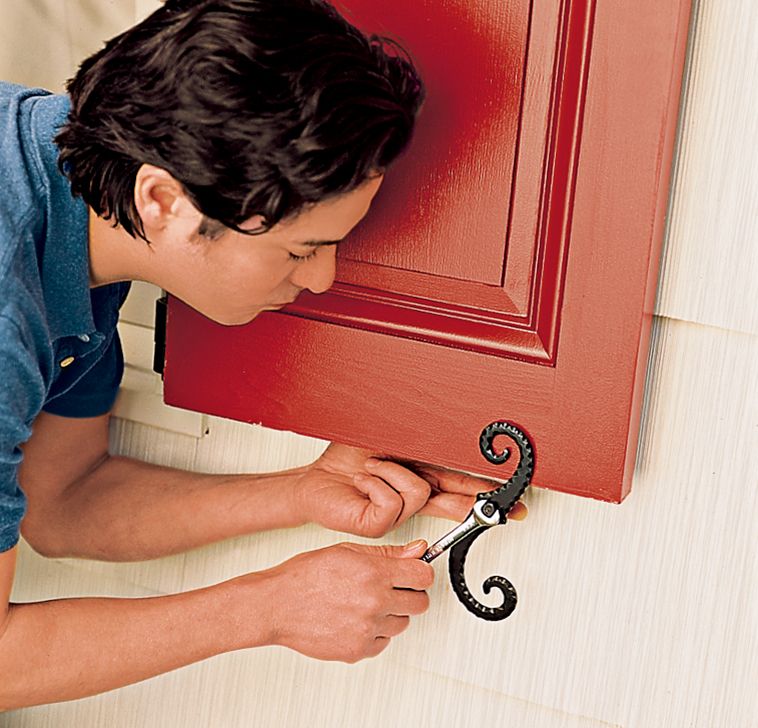
Assemble the shutter dog and the lag bolt that holds it away from the house. Open the shutters all the way. Position the dog on the siding under the shutter, 4 inches in from the shutter’s outer edge and 1 inch below the bottom edge. Holding the bolt up against the house, check that it has enough contact with the shutter to hold it open. Then, spin it sideways and check that the shutter can clear it to swing closed.
Once you’re satisfied with the dog’s position, mark the bolt’s location. Drill a pilot hole at the mark. Using a wrench, twist the bolt into the siding. Repeat the process for the other dog.
Step 8: Attach the locking hardware
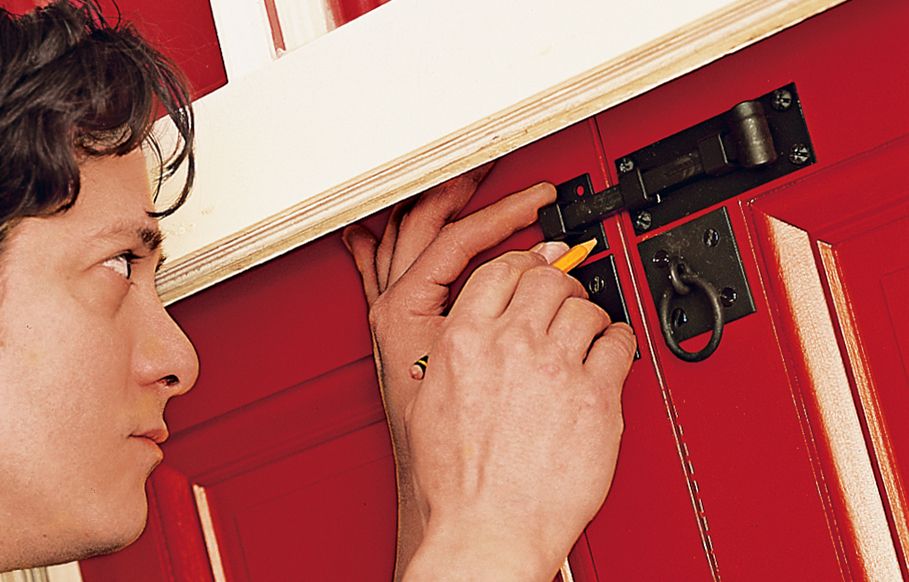
Close the shutters and move to the inside of the window. With a helper holding the shutters closed, position the other pull in line with the one you attached above. Mark the screw holes, drill pilot holes, and attach the pull.
Position the latch in line with the bolt and the pull below it. Slide the bolt into the latch to ensure the shutters lock properly when closed. Mark the screw holes, drill pilot holes, and attach the latch.
Step 9: Attach the copper capping
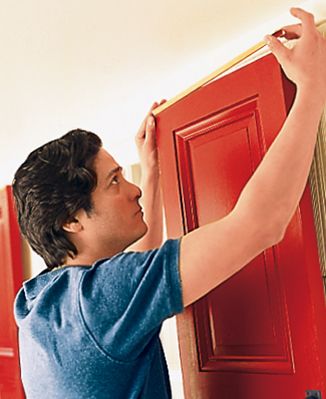
Squeeze a bead of silicone adhesive on the underside of the copper capping and slide it over the top edge of the shutter.
Fine-Tuning and Adjustments to Your Exterior Shutters
After installation, you may need to make some adjustments to ensure your shutters function properly and look their best.
Testing Shutter Operation
Open and close the shutters several times to check for:
- Correct functioning of latches and shutter dogs.
- Proper alignment when closed.
- Smooth operation without binding.
Making Necessary Adjustments
If you encounter issues during testing:
- Adjust hinge positions if shutters don’t close flush.
- Realign shutter dogs if they don’t hold shutters open securely.
- Tighten or loosen hardware as needed for smooth operation.
Adding Finishing Touches
Complete the installation with these final steps:
- Touch up any paint scratches that occurred during installation.
- Apply a bead of exterior caulk around the hinge pintles to prevent water infiltration.
- If desired, add decorative elements like S-hooks or faux hinges for non-functional shutters.
Maintaining Your Exterior Shutters
Regular maintenance will keep your shutters looking good and functioning properly for years to come. Establish a routine for cleaning, inspecting, and addressing any issues.
Cleaning and Inspecting Regularly
Your shutters will need consistent checkups to stay in good shape. Perform these tasks at least twice a year:
- Check for any gaps that may have developed between the shutters and the house.
- Clean shutters with mild soap and water to remove dirt and debris.
- Inspect for signs of wear, damage, or loose hardware.
Repainting and Refinishing
Every few years, or as needed, you will need to refine the finish on your shutters. This will look like:
- Sanding and repainting or re-staining shutters to maintain their appearance and protective coating.
- Pay special attention to the bottom edges, which are most susceptible to water damage.
- If they become damaged, you may need to learn how to repair an external shutter.
Addressing Common Signs of Aging
Be proactive in addressing problems as they arise. In particular, you will want to:
- Adjust shutters that have become misaligned due to house settling or extreme weather.
- Replace damaged or rotted wood components as soon as possible.
- Tighten loose hardware promptly to prevent further issues.
Our Conclusion
Remember that while this guide provides a comprehensive overview, every home is unique. If you encounter challenges or feel unsure about any step in the process, don’t hesitate to consult a professional.
The investment in properly installed exterior shutters will benefit your home’s curb appeal and value.
